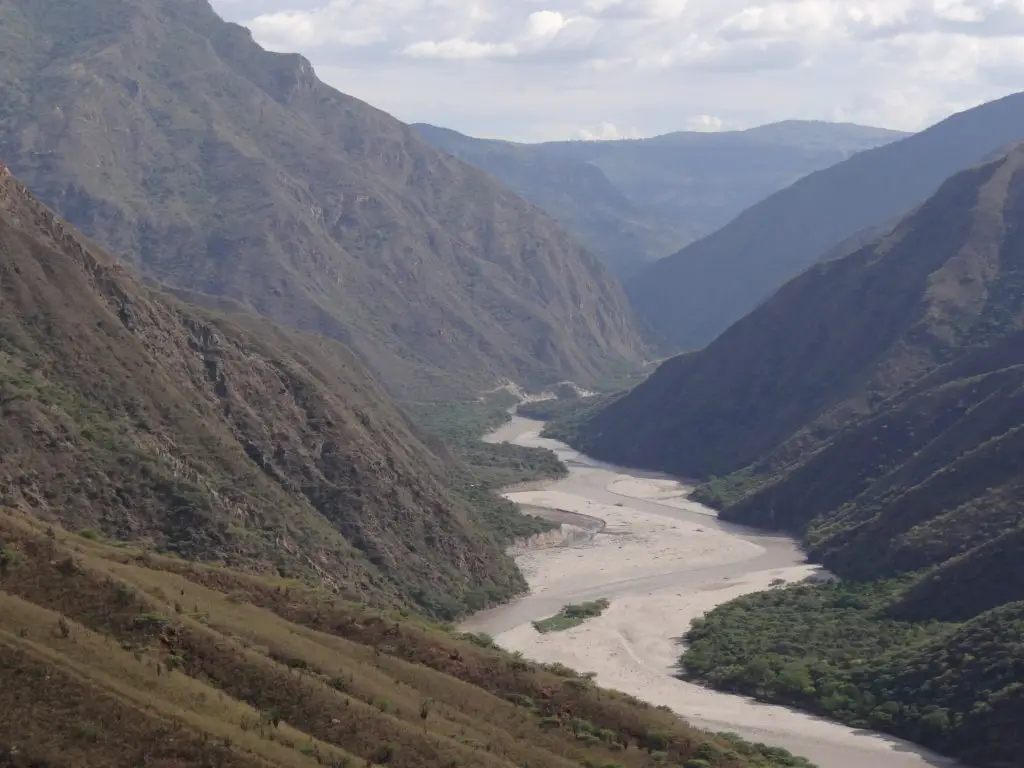The Chicamocha River flows through central-eastern Colombia, and the erosion of its riverbed has created the Chicamocha Canyon, a natural beauty much visited by foreigners and locals alike.
Indice De Contenido
Map of the Chicamocha River
The Chicamocha River, considered one of the most important water sources in the region, originates in the confluence of the Tuta River and the Jordan River in the department of Boyacá, in the Eastern Cordillera of the Andes (see also Cesar River).
From there it begins its course, entering the department of Santander and ending at its mouth, where it joins the rivers Suárez and Fonce to form the river Sogamoso in Santander.
The name of the Chicamocha River comes from the Guane language and means “silver thread on the night of the full moon”.
The Chicamocha river basin
The Chicamocha River basin covers an area of 1,36 square kilometres, sharing 367 km2 with the Jordan River and 441 km2 with the Tuta River, with an average altitude of 2,950 metres above sea level and a slope of 1.10%.
It drains about a third of Boyacá and its waters are fed by the Tuta, Sotaquirá, Chiticuy, Chiquito and Surba rivers.
It flows through the municipalities of Oicatá, Paipa, Tunja, Duitama, Tuta, Santa Rosa de Viterbo, Sogamoso, Firavitoba, Iza, Tibasosa, Cúitiva, Tota, Nobsa, Monguí, Pesca, Gámeza, Floresta, Mongua, Busbanzá, Tasco, Betéitiva, Cerinza, Corrales, Paz de Río, Socotá, Socha and Boavita.
Agricultural and industrial activities are a major development in the region surrounding the Chicamocha River, so the demand for its water for irrigation, human consumption and other uses is high, reaching 4.59 m3 per second.
There are two reservoirs that regulate the waters of the Chicamocha River, the La Copa Reservoir, located on the Tuta River, and the La Playa Reservoir, located on the Jordan River, and the Sochagota Lake, located in the town of Paipa (see also Zujar River).
The Chicamocha Canyon
As a result of the erosion of the Chicamocha riverbed and the movement of the tectonic plates, large gorges have formed on its banks, forming the Chicamocha Canyon, at the level of Boyacá.
It is part of the upper reaches of the Chicamocha River and was formed about 46 million years ago. It is one of the largest in the world, with an approximate length of 108,000 hectares, divided between Boyacá and Santander, and on its slopes, near Bucaramanga, is the Chicamocha National Park.
The Chicamocha Canyon has a beautiful rugged natural setting, which makes it a major attraction for tourism development (see also Pacuare River). The Chicamocha Canyon Race is an annual sporting event with jogging, running and walking distances of up to 167 km.
The race starts in San Gil and passes through picturesque villages that seem frozen in time, such as Aratoca, Panachi, Cepita Pescadero, Los Santos, Jordan, Villanueva, Barichara and Guane.
Pollution of the Chicamocha River
The Chicamocha River is the most polluted river in Colombia after the Bogotá River. Its waters have recently been heavily polluted, with serious consequences for its course and serious risks for the populations that depend on its contributions.
According to studies carried out by the Regional Autonomous Corporation of Boyacá, 40% of its pollutants come from Tunja, 30% from Duitama and 20% from Sogamoso.
This pollution comes from sewage, industrial and hospital waste, pesticides, agricultural and livestock waste, car fats, coal by-products and other elements of steel production, mercury, cyanide, sulphates, etc., which contaminate the source and give rise to unpleasant odours in different sections.
According to the studies, the Chicamocha has different levels of pollution in different parts of its course, and from Tunja to Tuta, for example, it is severely polluted with water that cannot be used in any way.
On the other hand, from Tuta to Sogamoso it is “acceptable”, and from Sogamoso to Vado Castro it can be considered polluted. In Vado Castro and up to Paz de Río, the risk is serious, and from Paz de Río to Soatá it is better.
The problem of the contamination of the Chicamocha River requires immediate attention to the current risks in order to maintain optimal results in the long term and avoid the continuation of the neglect to which it has been a victim for a long time.
The lack of important and sufficient environmental measures, as well as the lack of investment and monitoring of the companies that dump their waste in the river, have been decisive in allowing the water to deteriorate to the extent it has.

